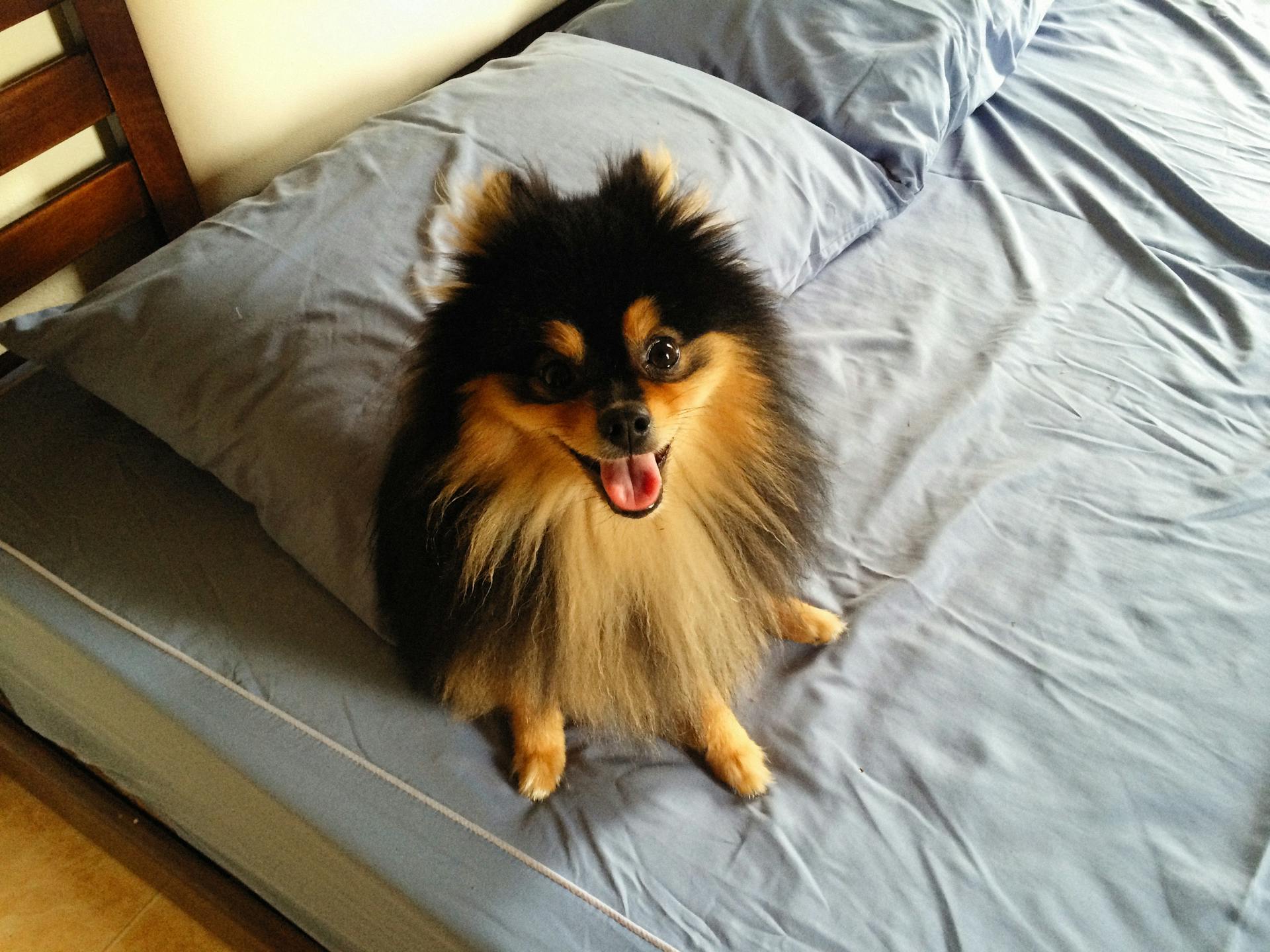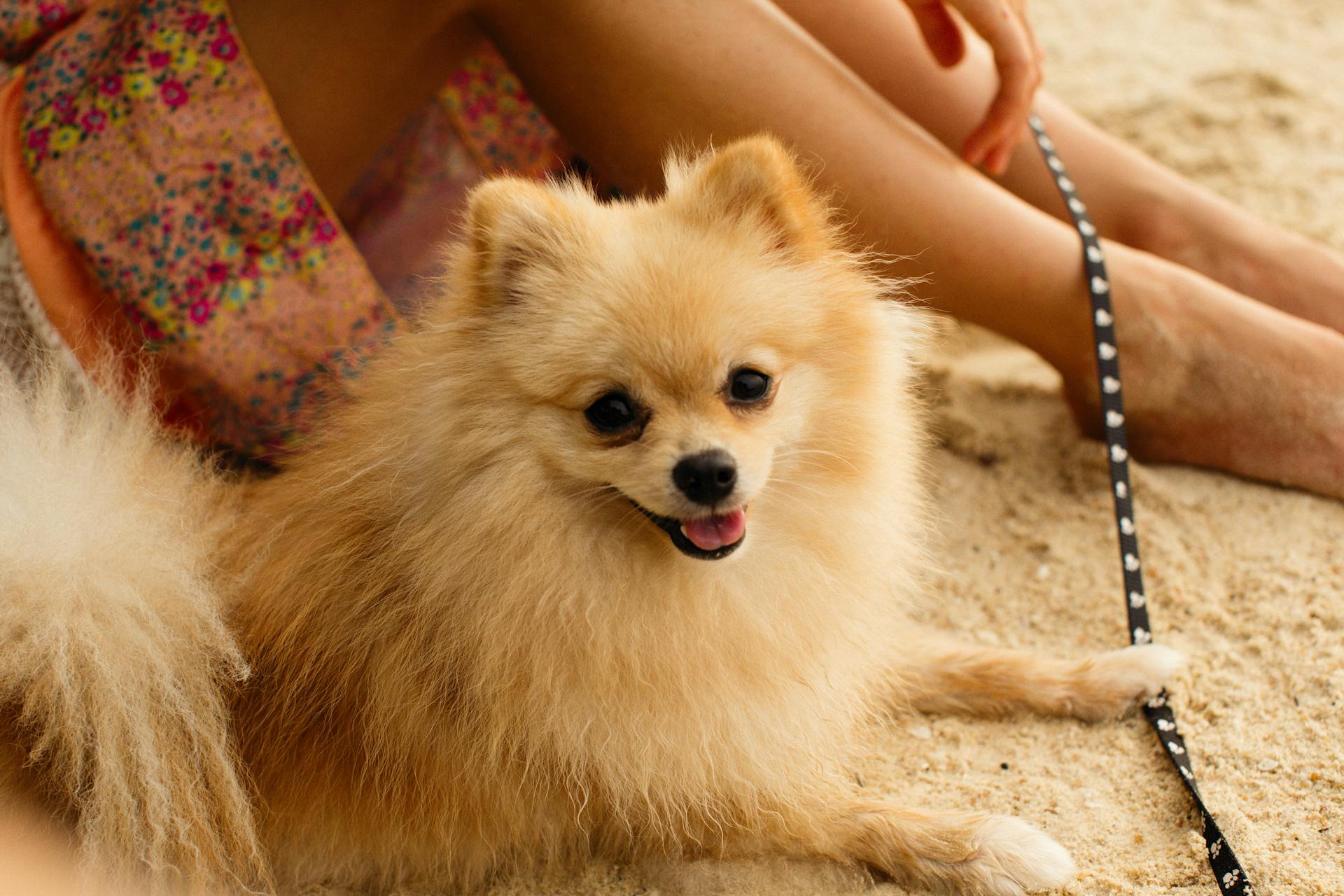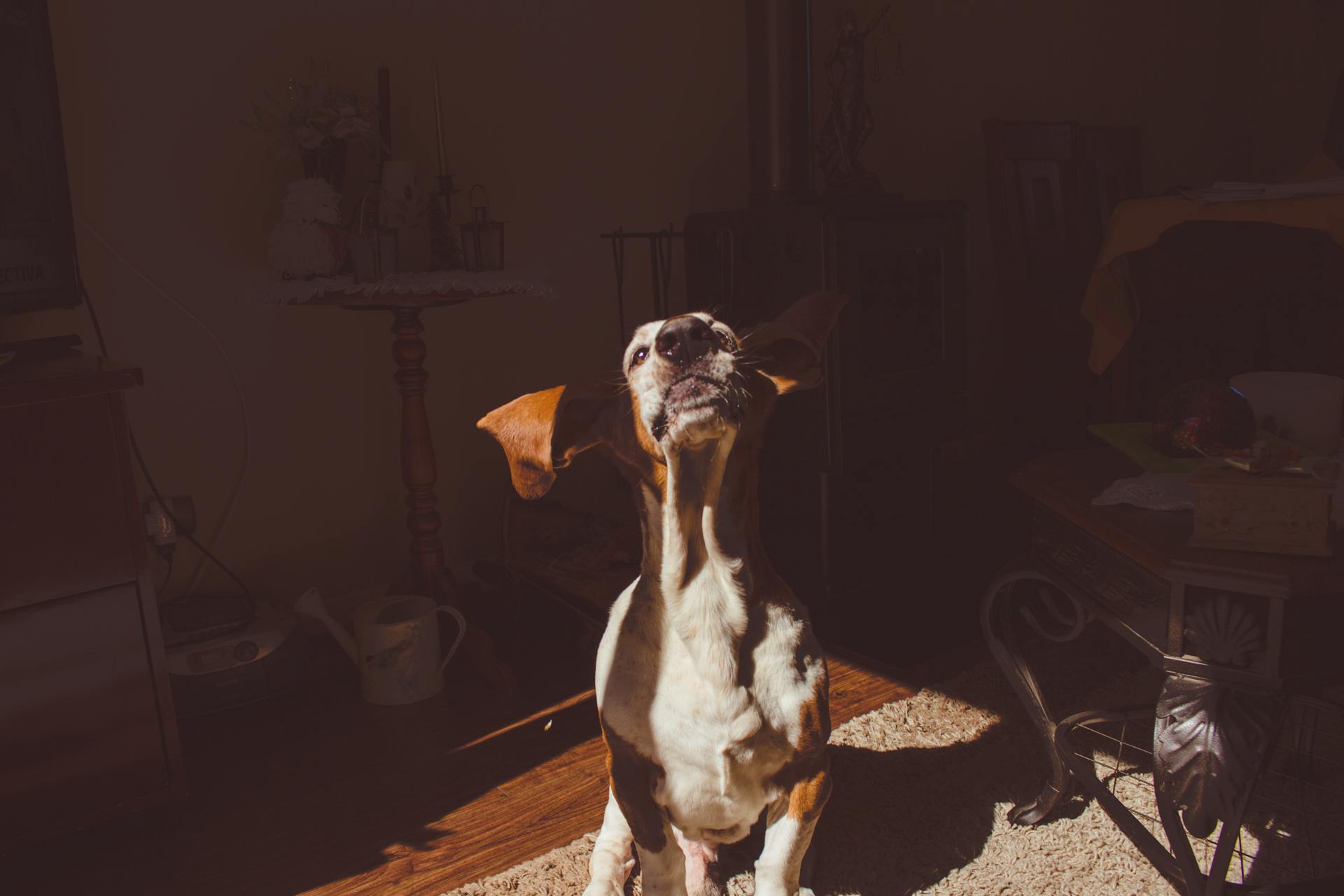
The Pomeranian Teddy Bear Dog is a breed that's sure to capture your heart. They originated in Germany and were bred to be a companion dog.
Their small size, typically weighing between 3-7 pounds, makes them a great fit for city living or apartments. They have a thick double coat that requires regular grooming to prevent matting.
These adorable dogs are known for their friendly and outgoing personalities. They're highly social and love being around people.
Care and Health
Feeding your Pomeranian a well-balanced diet is crucial to preventing patella luxation, a common health issue for toy dog breeds.
Your Pomeranian needs daily exercise to stay healthy and happy, but be sure to check with your vet for the right amount of physical activity.
Regular visits to the vet are essential to catch any potential health problems early on, such as heart disease, severe hair loss, cataracts, or idiopathic hypoglycemia.
Explore further: Veteran Dog Treats
Health Issues
As a responsible Pomeranian owner, it's essential to be aware of the potential health issues your furry friend may face. Patella luxation is a common health issue in toy dog breeds, causing the kneecap to become loose and slide out of place.
This condition requires regular check-ups with your vet, ideally once a year, to catch it early. If left untreated, surgery is the only solution.
A well-balanced diet and daily exercise can help prevent patella luxation, but it's not the only health issue to worry about. Other potential problems include heart disease, severe hair loss, cataracts, and idiopathic hypoglycemia.
Regular visits to your vet are crucial to monitor your Pomeranian's health and catch any issues early on. By doing so, you can take steps to prevent or manage these conditions and keep your furry friend happy and healthy.
They Live Long
Pomeranians are known to live a long life, with an average lifespan of up to 16 years old.
Proper care and attention can significantly contribute to their longevity. This includes regular veterinary check-ups, a balanced diet, and plenty of exercise and playtime.
A well-cared-for Pomeranian can live a happy and healthy life, free from many common health issues that plague other breeds.
Pomeranian Characteristics
Pomeranians are energetic dogs that will often try to get your attention by standing on their hind feet.
They have a stubborn personality, making training a bit challenging, but it's possible with their bright nature.
These dogs need frequent human interaction, love, and exercise to stay happy and well-adjusted.
They are suitable for families with older children and couples, but not ideal for small spaces due to their need for exercise and attention.
Pomeranians have a fluffilicious double coat, expressive eyes, and a button nose, making them look like a baby fox.
They adore spending time with their humans, snuggling on warm laps or catching rides in tote bags, and can be carried due to their small size.
See what others are reading: Cute Dog Types Small
Breed Characteristics
A healthy Pomeranian can live for 16 years or more with good care.
Pomeranians are prone to certain health conditions, including congestive heart failure, black skin disease, patella luxation, and seizure disorders.
This breed is not for everyone, especially families with young children, as Pomeranians can be a bit challenging to train due to their stubborn personalities.
However, with patience and consistent training, Pomeranians can learn quickly and easily, thanks to their bright nature.
They need frequent human interaction, love, and exercise, making them well-suited for families with older children or couples.
Pomeranians are energetic and love to get attention, often standing on their hind feet to get your attention.
Their small size, weighing only 3-7 pounds, makes them perfect for carrying around in tote bags or snuggling on warm laps.
Despite their small size, Pomeranians have big personalities and can be quite protective of their family, making them great family guard dogs.
Consider reading: Are German Shepards Good Dogs
Faces - Baby Doll or Fox Faced
Pomeranians come in a variety of face shapes, with some resembling baby dolls and others fox-like.
Their baby doll faces are a result of their short, compact muzzle and large, dark eyes.
Adoption and Ownership
Before adopting a Pomeranian Teddy Bear dog, do your homework and consider if this breed is right for you. It's essential to research and understand their needs and characteristics.
You'll need to think about the costs of owning a dog, including dog food, vet visits, toys, and grooming. Some Pomeranians may require more grooming to maintain their adorable teddy bear appearance.
They are known to shed excessively and need to be brushed daily, so be prepared for regular grooming sessions. Regular brushing can help reduce shedding and prevent matting.
Pomeranians are generally great family dogs and can be taught to live peacefully with small children and other pets in the house. They have a bold and lively temperament, making them perfect for people of all ages.
General Information
The Pomeranian Teddy Bear Dog is a small, adorable breed that's perfect for city living. They typically weigh between 3-7 pounds.
Their thick double coat requires regular grooming to prevent matting, but it's worth it for the adorable teddy bear look they get.
History of the
The Pomeranian's history is fascinating, and it all begins with its Icelandic ancestors. These arctic dogs worked as herders, guard dogs, and sled dogs centuries ago.

The Pomeranian's ancestors were transported to the southern coast of the Baltic Sea, where they resided in a region known as Pomerania. This is where the breed's downsizing first began.
In Pomerania, the Pomeranians were selectively bred to be smaller, eventually weighing between 30 to 40 pounds. This marked a significant change in the breed's size.
King George III's marriage to the daughter of the Duke of Mecklenburg-Strelitz brought Pomeranians to England.
Explore further: Wiener Dog Breed
What Is?
The Pomeranian is a dog breed that originated in Pomerania, a region in Central Europe. They were bred as companion dogs for royalty and nobility.
The Pomeranian's history dates back to the 16th century, when they were bred from larger sled-pulling dogs.
Pomeranians are known for their small size, typically weighing between 3-7 pounds.
Their dense coat makes them resemble a teddy bear, which is why some people refer to them as Teddy Bear Pomeranians.
Frequently Asked Questions
How much is a mini Pomeranian teddy bear dog?
A reputable breeder typically charges between $1500-$3000 for a Pomeranian, but prices may vary depending on factors like bloodlines and location. If you're interested in bringing a mini Pomeranian home, we can help you explore your options and find a breeder that fits your budget.
What is the difference between a teddy bear Pomeranian and a teacup Pomeranian?
There is no official difference between a teddy bear Pomeranian and a teacup Pomeranian, as these terms are unofficial and refer to the same toy breed.
Do teddy bear Pomeranians shed?
Yes, teddy bear Pomeranians shed their undercoat twice a year, requiring regular brushing to prevent matting and tangling.
Sources
- 14 Teddy Bear Dogs That Are Undeniably Adorable (rd.com)
- their behavior (petpom.com)
- need to be brushed daily (petkeen.com)
- What Is a Teddy Bear Pomeranian? History & Health Issues (hepper.com)
- Pomeranian faces – Teddy Bear, Baby Doll, or Fox Faced (keenpomeranians.com)
Featured Images: pexels.com


